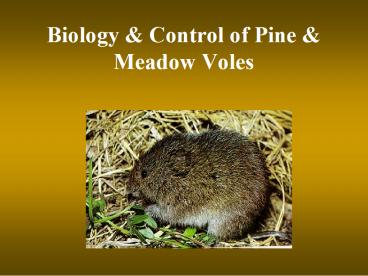Biology PowerPoint PPT Presentation
1 / 28
Title: Biology
1
Biology Control of Pine Meadow Voles
2
Biology of Voles
- 2 species in SC
- Pine vole (underground) - root damage
- nests underground
- Meadow vole (above ground) - trunk damage
- nests above ground
- Also called meadow mice
- Short tails, small eyes,
small ears - Both eat seeds, fruit, grass
- Can breed throughout year (1-5 litters/year,
1-11/litter)
3
The Differences
4
Molecrickets
5
Mole
6
Eastern Mole
7
Pine Vole
8
Meadow Vole
9
Meadow Vole
10
Vole Hole Identification Voles vs. Moles
- Since voles are not the only animal
pests responsible for
runways in lawn and garden areas, they are often
confused with - these other pests you'd like to
get rid of namely, moles. - Because both moles and voles
are rarely seen, it makes more - sense to base identification on
the signs they leave behind, - Moles produce two types of runways in your yard.
One runway - runs just beneath the surface.
These are feeding tunnels and - appear as raised ridges running
across your lawn. The second - type of runway runs deeper and
enables the moles to unite the - feeding tunnels in a network.
It is the soil excavated from - the deep tunnels that
homeowners find on their lawns, piled up - in mounds that resemble little
volcanoes. These mounds are a - dead giveaway that your problem
is not voles, but moles. Voles - leave no mounds at all behind.
11
Mole Tunnels and Hills
12
Vole Tunnel
13
(No Transcript)
14
Damage Damage Identification
- Can cause extensive damage
- orchards, ornamentals, tree plantings, field
crops, gardens, flower beds, lawns, golf courses
15
Damage Damage Identification
- Signs
- girdling and gnaw markings
- (1/8 inch wide, 3/8 inch long)
- extensive runways
- vegetation clipped near runways
- spongy ground
16
Vole Damage
17
Damage to Roots
18
Damage at Ground Level
19
Pine Vole Damage at Roots
20
Damage to Root Tubers
21
Damage to Junipers
22
Damage Prevention Control
- Exclusion
- Hardware cloth cylinders
- 1/4 inch mesh
- bury wire 6 inches
- not cost effective on large scale
23
Damage Prevention Control
- Habitat Modification
- Reduces but not eliminate damage
- Remove weeds, ground cover, and litter
- Lawn turf regularly mowed
- Mulch cleared 3 feet or more from base of trees
- Soil tillage destroys pine vole tunnels
- Research indicates some species of grass
(orchard) not preferred by meadow voles
24
Damage Prevention Control
- Frightening Devices
- Sonic and other devices do not work!
- Dont waste money.
25
Damage Prevention Control
- Repellents
- Taste
- Thiram or capsaicin (hot ingredient in chilis)
for meadow voles - Short-term protection at best
26
Damage Prevention Control
- Toxicants
- Zinc phosphide baits most commonly used
- Single-dose toxicant
- Anti-coagulants
- Multiply-dose toxicants
- Placed in runways burrow entrance (MV)
- Placement important for PV
- Tunnel entrances
- Cover with shingles or wood plank
27
Damage Prevention Control
- Trapping
- Snap traps in runways tunnel systems
- Procedure for PV very important
- PV bait with sliced apple, MV peanut
butter/oatmeal mix - Fall and winter are best times to trap
28
Damage Prevention Control
- Other Methods
- Predators
- least shrew, owls, coyotes, foxes
- cats
- some dogs

